Growing food is a cultural act
"I have great faith in a seed," wrote Thoreau. Me, too, if those seeds align with my principles. Thoughts on principle-driven garden practice.
I'm a big fan of principle-driven practice, because our principles keep us on the path we want to be on. In my early 20s, I articulated my overarching life mission like this: "Making positive contributions to healthy groups, clans, and communities." It has served me well, guiding me through decision-making in small and large ways. Specific principles act as guardrails and, as a market gardener, I have to keep both gardening practice and business in mind. I defined these four general principles at the very beginning of my market gardening life:
Pleasure means selecting varieties according to flavor, aroma, color and form as well as ensuring my work remains enjoyable and a garden is a pleasure to the eye.
Diversity means bringing together old and new, local and global varieties for four-season harvest as well as celebrating the cultures from which they come through their recipes.
Simplicity means working with nature using simple hand tools and ecologically sound methods as well as making business processes as efficient and convenient as possible.
Self-renewing means working with nature to build healthy soil and encourage diversity as well as ensuring that my business model enables me to do the work of producing flavorful, nutritious food for others.
While self-renewing refers to saving seed and allowing for self-sowing in the garden plan, all four apply to sourcing seed. Last weekend I went to the annual seed market in my region, where the incredibly diverse offerings of local seed producers always entice me to break my budget. I rarely really need seeds, because I stash them much like knitters stash yarn (another thing I do), and in a pinch I could keep my garden going on just the seeds I save. We’d have to do without cucurbita (squash, zucchini, cucumbers and melons), because those are the only seeds I don’t produce myself. Otherwise, we’d be good to go.
The seeds available at this particular market are predominantly varieties from Austria’s seed bank, run by the non-profit Ache Noah. One particular seed grower, Kathi Soos / Sortenwerkstatt, focuses on varieties that are not listed in the official registry of the European Union. She does this for the love of open-pollinated, heirloom, land-race varieties, but also because it is safer for her commercially. As the pressure and leverage from big ag lobbyists rises, monitoring and restriction on seed production accelerates. Seeds, too, are restricted now - I can no longer order seeds outside of the EU.
This restriction is disturbing, especially in the day and age of patents on seeds and biopiracy (corporations stealing land races and patenting them). Seed sovereignty is the foundation of food sovereignty. If we cannot produce our own seed, we cannot guarantee next year’s food. Now, I’m not a “prepper” or a “doomsdayer”, but I know the value of good seed that has a chance to adapt to my particular growing conditions. Others seem to agree with me; saving seed is key in Article 19 of the UN Declaration on the Rights of Peasants and Other People Working in Rural Areas:
1. Peasants and other people working in rural areas have the right to seeds, in accordance with article 28 of the present Declaration, including: (a) The right to the protection of traditional knowledge relevant to plant genetic resources for food and agriculture; (b) The right to equitably participate in sharing the benefits arising from the utilization of plant genetic resources for food and agriculture; (c) The right to participate in the making of decisions on matters relating to the conservation and sustainable use of plant genetic resources for food and agriculture; (d) The right to save, use, exchange and sell their farm-saved seed or propagating material.
2. Peasants and other people working in rural areas have the right to maintain, control, protect and develop their own seeds and traditional knowledge.
3. States shall take measures to respect, protect and fulfil the right to seeds of peasants and other people working in rural areas.
…
Formulating the essence of things
Many of us in Western societies probably have little or no identification with “peasants.” Yet, our lives are more connected than we realize, particularly through the food we eat. "Eating is an agricultural act," is a powerful statement from Wendell Berry, a US American author, poet, environmental activist, cultural critic, and - last but not least – farmer. Berry is well-known in market gardening circles for his thoughtful essays on farming and consuming. He has written much on recognizing the connection between field and food in order to fully appreciate and enjoy what we eat (see “The Pleasures of Eating”). Farmers cannot meet society’s sustainability goals alone. Food production is the first step, but full circle is only reached through consumers’ decision-making in purchasing, preparing and eating. We are entangled with one another and with nature. We also entangle ourselves with corporations and international trade, depending on how the seeds we sow and the food we buy were grown.
When I started my first market garden, I reflected deeply on what my work was all about. Not only did this result in clear principles and how they manifest themselves in my practice, but Berry’s statement led me to my own: "Growing food is a cultural act." Yes, that’s it! This is what my work is all about! My decision to grow food for others as the source of my livelihood led to a long chain of more decisions: What will I produce? Why? For whom? At what price to the environment? At what price to me? I quickly settled on growing for foodies like me, which determined the choices I made regarding varieties and seasonality. Pleasure, diversity, simplicity and self-renewal are my criteria for the first step in that process, buying seeds.
It was an egotistical decision to grow what I wanted to eat, but it had an essential perk: It gave and still gives me joy, and that joy keeps me going when the going gets tough. A field of resonance also emerged and chefs quickly entered my life, because my choices spoke to them as well. They were delighted by the seasonal salad mixes and heirloom varieties they could highlight on their menus. We learned from one another as we walked through the garden, sampling new varieties and various parts of a plant. Can you grow mashua? (Mashu-what? Sure!) Have you tried young radish pods? (Great, I’ll pickle them!) When I harvested an heirloom carrot by the name of ‘Duwicker’ and told its story, a chef tried it, loved it and created a whole course around it. The challenge for me was to ensure I had a certain volume in a particular size available for a six-week period. We were both enjoying ourselves.
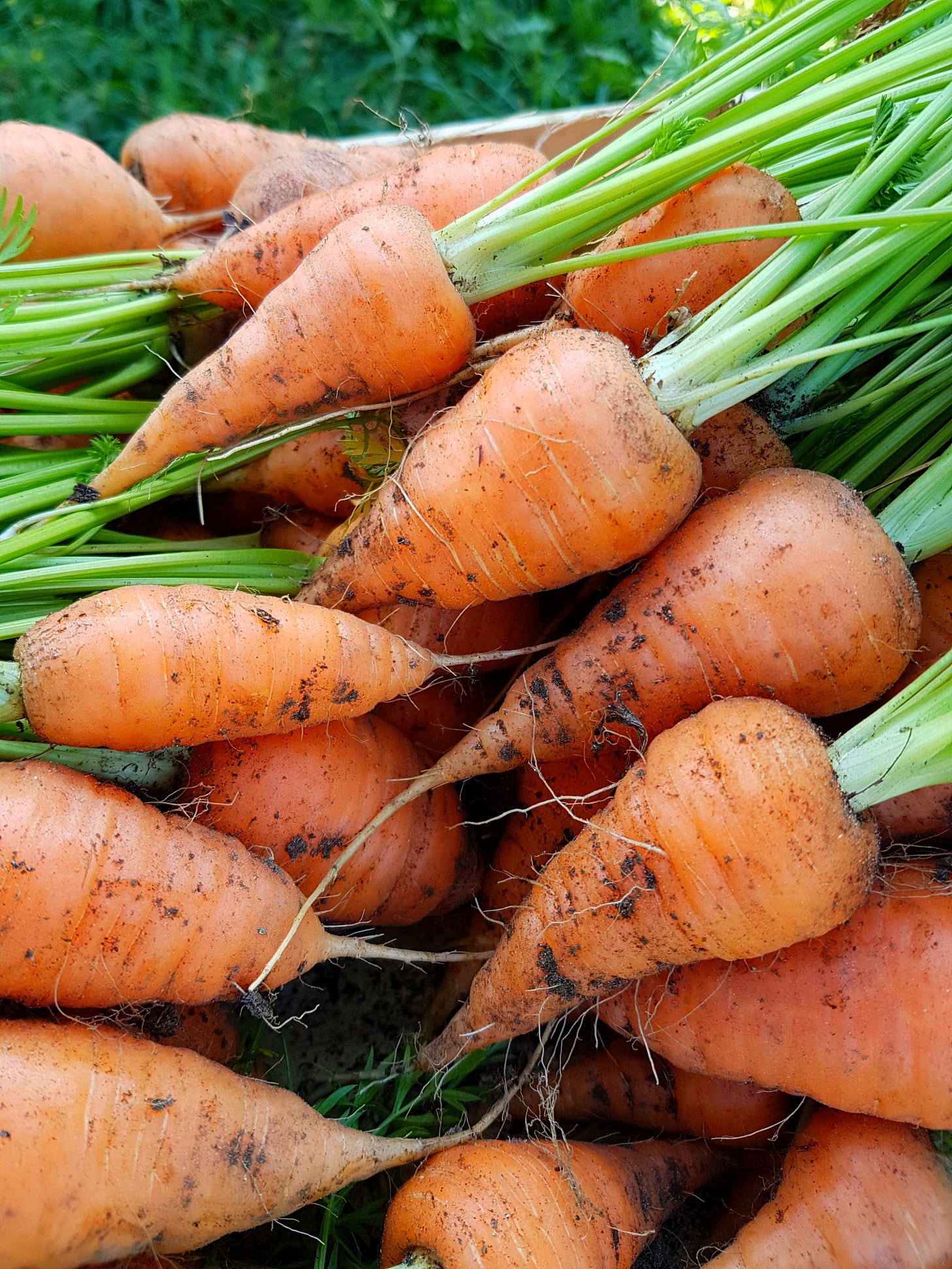
When I say growing food is a “cultural act,” I mean all of this: What I grow, how I grow it, and for whom. I want to know the origins of a variety whenever possible and I tell their stories at every opportunity. My choices must be a delight to the eye and the tastebuds. Ideally, I can propagate it myself, whether via tubers, cuttings, or seed.

The Politics of Seeds
When it comes to land use, seed origins and growing practices, growing food is also a political act. In a recent network meeting with market gardeners, a new member seemed to want to pre-empt any criticism of his choices by defending his use of hybrid tomatoes in his greenhouse. He is a classically trained horticulturalist who works hard and smart, focuses on efficiency and quality, and rocks it at the local farmer’s market. Why did I detect a bit of defensiveness? In any case, the group didn’t engage in the topic and no discussion ensued regarding open-pollinated and heirloom varieties. We had already exchanged our dogmas, positions and principles. Each of us is aware that the choices we make become a part of our own unique brand. Despite differences, our common denominators make us identifiable as market gardeners.
I happen to be one of those almost dogmatic avoiders of patented seed like Salanova® lettuce and hybrids. (Find out more about why patents on seeds are dangerous to food sovereignty here.) Hybrid cultivars aren’t bad in and of themselves. We do, however, need to know where those seeds come from, especially if we stand for specific values. The big and powerful business behind hybrid tomato seeds has been explored in a French documentary, available in English on YouTube: Seeds of Profit: Why fruit and vegetables are the new gold. Did you know that by weight tomato seeds are more precious than gold? That their fruits are less nutritious? That the seeds are produced on the backs of women and children in India? Many other seeds have a similar story, from watermelon to lettuce.
Why would I want to be entangled with that legacy? For me, the start of my practice is a seed, so I want to source it as carefully as I would select veg at the farmer’s market. I’m not perfect, though, and I have made mistakes. One was to order seed from a French company called Graines Baumaux. The spectrum on offer is astounding, from the Japanese carrot called ‘Kuroda’ to the Czech radish called ‘Zlata’, which is why I enjoy their catalogs so much. The seed quality is very good and the prices are reasonable. Plus, their standardized seed packets are delightfully colorful.
Needless to say, I was very disappointed to discover that Graines Baumaux had been in a legal battle with Kokopelli, a non-profit seedsaving association in France that maintains an excellent choice of organically certified, open-pollinated, heirloom varieties and sells them. Graines Baumaux accused Kokopelli of unfair competition because they were selling varieties that were not registered in the EU’s list. Kokopelli won, because EU law also ensures that heirloom varieties worthy of preservation can also be sold, whether or not they are officially registered. (The decision can be read here.) If Graines Baumaux had won, heirloom seed would have quickly become contraband.
Hybrids - those seeds marked with F1 - are a different issue. They are produced by crossing two different varieties through artificial pollination and are thereby genetically unstable. It can take up to ten years to achieve a genetically stable tomato from a hybrid. I know, because I had an accidental cross that appeared in one of my tunnels and produced lovely pink cherry tomatoes. I’ve been growing them out and selecting for a delicious, delightful pink cherry tomato, currently in F5, the fifth generation. (More on that in another newsletter.) This genetic instability is why hybrids limit food sovereignty.
As far as genetically modified crops, well, you probably know what I think about them.
In case this has become a bit confusing, here’s a summary of the terms:
heirloom vegetables: varieties that have been handed down from one generation to the next or shared in a community for a long time - many consider all varieties grown before hybridization began in 1951 to be heirloom
open-pollinated: varieties that remain stable and true to type when pollinated naturally - all heirlooms are open-pollinated, but not all open-pollinated varieties are heirlooms
hybrids: varieties that were artificially pollinated, usually by hand, and produce seeds that are not genetically stable, so they cannot be saved to propagate the same plant in the next generation (not true to type)
GMO: genetically modified organisms that are easy to patent, because the changes were made in a laboratory or are related to proprietary technology, also not true-to-type if natural propagation is even possible

To come back to my principles and sourcing seed, here’s the message: The origins of my seeds are just as important to me as everything else I do to respect my principles. Ideally, I know the grower or can at least trace back to the grower. The non-profit seed distributor called Dreschflegel (see photo above) in Germany is one such source. Their seeds are listed with the name and location of the producer. If provenance is also important to you, have a look around online or even in your region - I’m sure you’ll find similar sources! A good place to start in the UK is https://www.seedsovereignty.info/ and Seed Savers Exchange in the US. Australians might want to check out Seed Savers Foundation.
Please share your recommendations for open-pollinated and heirloom seed in the comments section!
What I’m doing this week
We had the coldest weather of the winter this week, with temperatures dipping to -8° C / 17.6° F . As I’ve mentioned in previous newsletters, I live in what used to be USDA Zone 7a, but we have gone south a zone or two when it comes to lowest temperatures.
It is only fair (and honest) to share my big mistake this week. I was too distracted by brunches and seed markets this past weekend to check on the seedlings I’d sown. Two lettuce varieties germinated faster than expected and immediately began reaching for the light. The result was leggy specimens that I had to resow. I’m only growing them out to prove a point - too much warmth and too little light is not a good thing.
The other seedlings are looking much better. As soon as they appeared, they went outside during the day to cool down and slow down; temperatures were just above freezing, but they were fine. We were all grateful for a bit of sunshine, which had been a rare thing recently.
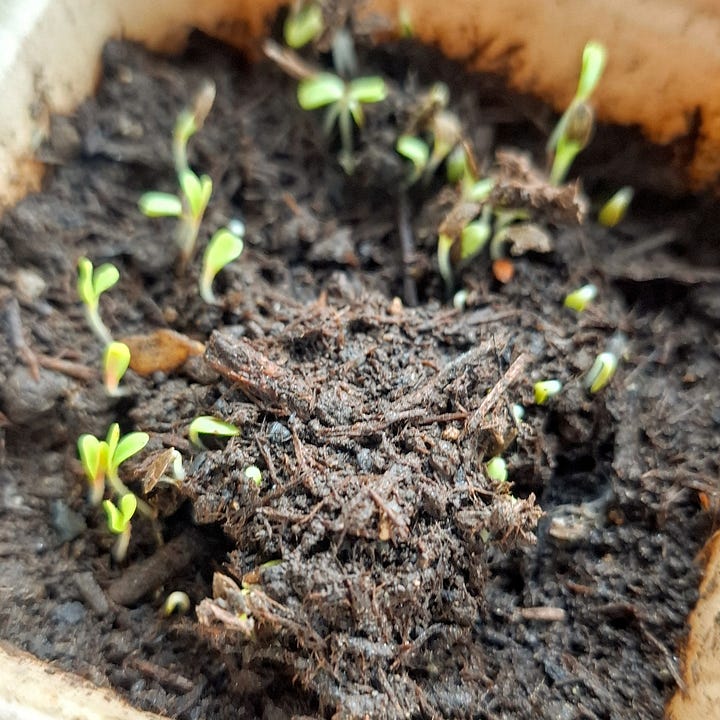
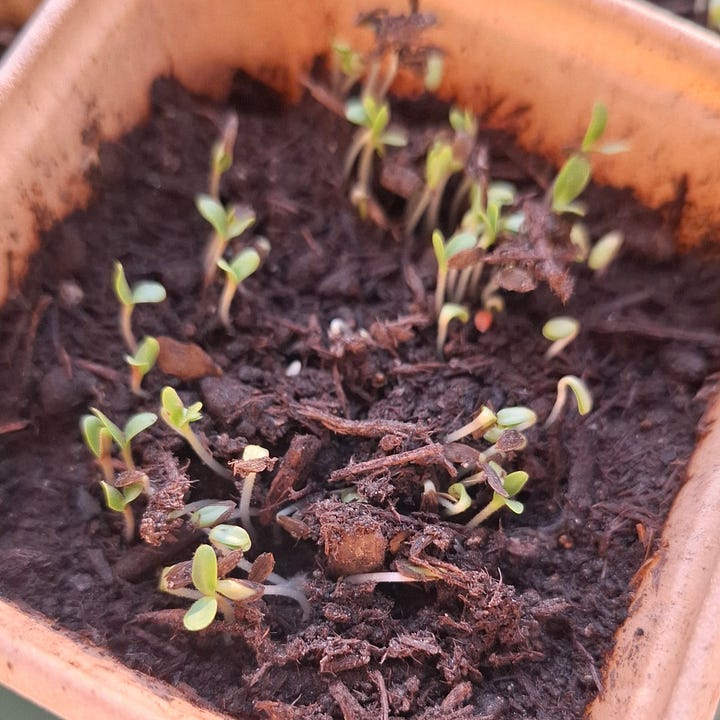
Seed viability is currently a topic in my Garden Circle, a virtual group of gardeners I guide through the season. Some of us have observed that our own saved seed is viable longer, and I happened to prove that point this week with bunching onions. Despite the fact that the seeds were two years old and onions notoriously lose their viability quickly, I sowed them anyway. They germinated within five days. Five days! My theory: It’s all in the seeds’ microbiome. I clean seeds as much as necessary, so plant material is often still on them. Whether that helps? It might preserve the microbiome better, which is a significant factor for a plant’s start in life. I also assume my seeds’ microbiome is more complex because the mother plants were grown without pesticides and herbicides. Anyone know a scientist who could test my theory?
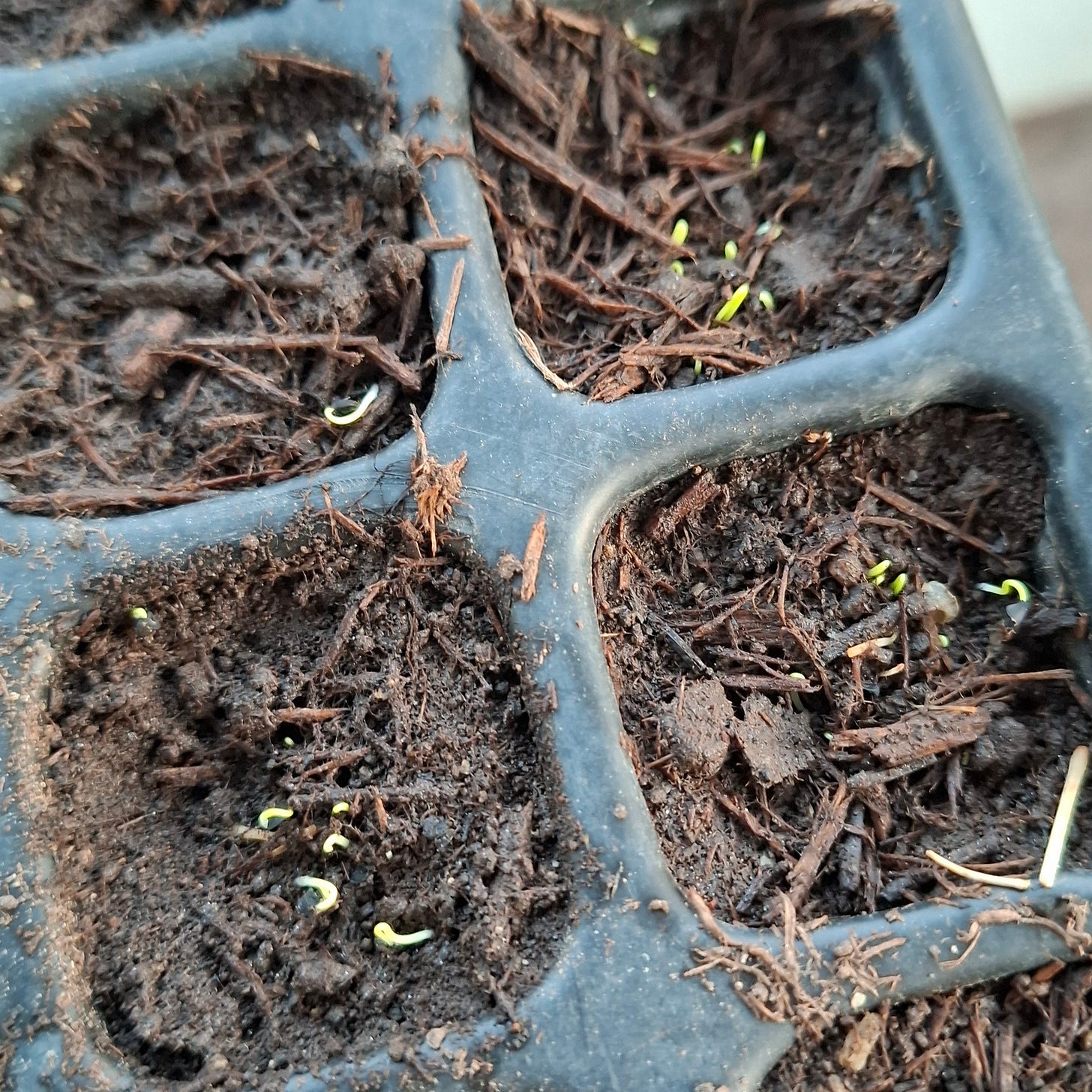
Here’s what’s on the list this coming week:
Take care of seedlings and keep an eye on germination.
Sow spinach in any gaps in the polytunnel with winter greens.
Water both tunnels, if the weather warms up. They’re very, very dry.
Order seed potatoes.
Finalize garden plan for the start of the season.
The list might seem easy, because it is. It will get longer in March when direct sowing and starting tomatoes happens. Until then, I’m enjoying the relaxed pace of my days, teaching courses and writing here on Substack.
Have a great week!




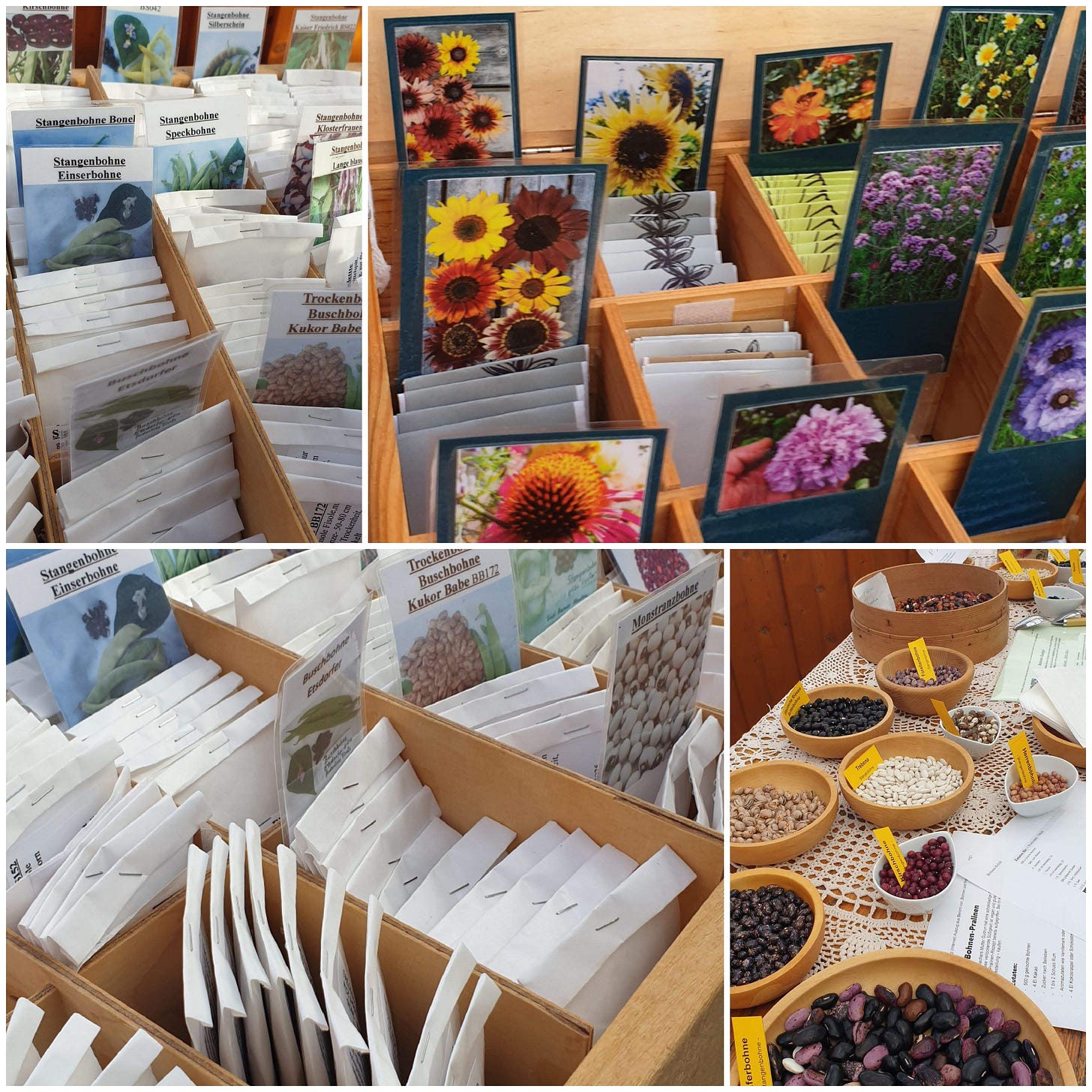



Fantastic article, really well researched and covers so much. That seed fair looks fantastic and a lot like our annual Reclaim the seeds festival in the Netherlands. A few years ago Ache Noah and Kokopelli used to have stalls there too but now sadly it's no longer as Europe wide as it once was.
Excellent article - and I never knew that Kokopelli had had to fight a legal battle, what a sad situation but so glad they can keep selling their wonderful selection of seeds.